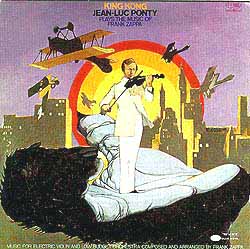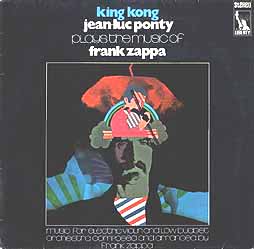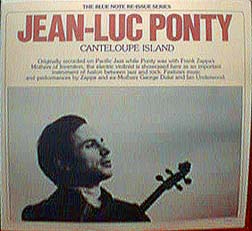JEAN-LUC PONTY
by Leonard Feather
The role of the violin in contemporary Improvisation has been an anomaly from the early years of this century. Until a few years ago, lt was classified under "miscellaneous Instruments" in any discussions, or popularity polls, that dealt more fully with such long established components of the orchestra as the trumpet, saxophone, trombone and clarinet. This somewhat derogatory pigeonholing could be ascribed, at least in part, to the technical demands involved in developing any true mastery of the Instrument. Another reason may have been the lack of job opportunities, particularly for black musicians.
Despite such problems, the violin played a more important part in jazz during the ragtime era than lt did after the official arrival of the jazz band. In many areas, the violinist was considered a logical choice to lead an ensemble. When Duke Ellington opened at the Cotton Club in 1927, this auspicious turning point in his career was marked by the appointment of the violinist to stand in front of the ensemble, a move presumably designed to impart an air of respectablllty. This innovation was short-lived, as Duke quickly showed his personal capacity for leadership.
For a long while the violin was regarded not only as a symbol of dignity but also as something vaguely exotic and perhaps non-American. lt is not without significance that the late Eddie South (1904-1962), one of the first great jazz violinists, undertook some of his extensive studies in Budapest, and that a distinct gypsy strain ran through much of his work. lt is remarkable too that of the five violinists elected to the top places in Downbeat's Fortieth Annual Readers Poll at the end of 1975, four were European born. Admittedly, one of them, Joe Venuti, spent only a few years in his native Italy before his family settled in Philadelphia; yet his heritage may weil have something to do with the development and nature of his talent.
The characteristics inherent in Venuti's work are even more dramatically evident in that of Stéphane Grappelli, who recently enjoyed belated acceptance among American audiences during his first tour of this country at the age of 68. Similarly, Michal Urbaniak, who ran second in the voting to Grappelli's third, brought with him something quite personal and influential when he left his native Poland and settled in New York a couple of years ago. But the artist who best symbolizes the full emancipation of the violin from miscellaneous Instrument to vital voice in today's music is the soloist from Arranches, Normandy, France. who occupied the poll's top slot, Jean-Luc Ponty. (The American born violinist, in case you are curious, was Jerry Goodman, who flnished in fourth place.)
The son of two academicians (his father taught violin, his mother, piano). Ponty began his studies at the age of five. Little over a decade later, he attended the National Conservatory of Music, where he won a prize. After two years wlth the Concerts Lamoureux classical orchestra, he made the transition to popular music, working as a sideman with the Jef Gilson band from 1961-4.
lt was not until he enjoyed a surprise success at the Antibes Jazz Festival in the summer of 1964 that he decided to stay in jazz on a full-time basis. The next years found him on the festival circuit, from Monterey (1967 and 1969) to Montreux (1972). Especially prestigious was an appearance at the Newport Jazz Festival in 1974. During this time he was involved wlth a series of artists representing diverse aspects of the American scene: Frank Zappa, George Duke, Mahavishnu, the first two of whom are represented in the present collection.
Zappa, by the time of his association with Ponty, had become an influential figure in an area too broad to be categorized by any such term as rock. Not for nothing was his group known as the Mothers of Invention. lt was dear to Zappa that necessity, in effect, was the mother of Jean-Luc Ponty, for nothing truly original had happened to the violin since the formative years of Stuff Smith and Ray Nance.
The man who brought them together was Dick Bock. the founding father of Pacific Jazz Records, a label whose influence had been pervasive throughout the 1960s. "I had heard more and more about Frank Zappa in jazz circles," he told me. "Then Frank played me some of the Hot Rats album on which he was still working. lt was hard to classify; just fascinating instrumental music. Then I took an acetate of Jean-Luc to Frank's house. A few days later Jean-Luc played on a Hot Rots track." As the two men fast developed an interest in each other's music, the concept of a collective project was born. Frank was particularly concerned with the development of an extended orchestral work, a formal piece tied to no one idiom and allowing Ponty interludes of expressive freedom. Music for Electric Violin and Low Budget Orchestra (possibly Zappa decided on this title after asking for 97 musicians and winding up with eleven men and a conductor) illustrates not only his mastery of composition and orchestration, but also of transition. lt emerges not as a fragmented series of ideas arbitrarily linked together, but as a securely integrated whole tbat moves with almost subliminal subtlety through various tempos, meters, moods and idioms. and from formal, written music to free-flowing blowing. Throughout its multitextured duration, from the opening bassoon figure to the demonic 7/8 violin passages at the end, this validity is retained and sustained.
lan Underwood, a former alto saxophonist and keyboard solist with tbe Mothers of Invention, who conducted this work, came to the project as the owner of a bachelor's degree from Yale and a master's from Berkeley in piano and composition.
Zappa, particularly impressed with the work of Donald Christlieb, described him to me as "one of the best bassoonists around, especially for the avant garde. He has played Stockhausen and does regular concerts of contemporary mosic." In recent years, Don's son, Pete Christlieb, has leapt to national prominence as a member of the Tonight Show band and soloist with Louie Bellson.
The drummer on this track and on King Kong, Arthur D. Tripp. III, formerly was a regular percussionist with the Mothers, but also spent two years with the Cincinnati Symphony. As Zappa commented, "he really gets into those meters." Buell Neidlinger, bassist on the same two tracks, was with the Boston Symphony Orchestra at the time of the recording, but Zappa observed, "I had to fly him out here—he's the only man I can think of who can play the bass part on the long piece." A forefather of the New Music, Neidlinger played with Cecil Taylor and Gil Evans in the 1950s.
Such tracks as King Kong, Idiot Bastard Son, and Twenty Small Cigars find Ponty in contexts that are generally closer to jazz than most of Zappa's work. This is true also of How Would You Like To Have A Head Like That?, a Ponty original arranged by Zappa. This it the most straight ahead blowing track of the Set, a basic G 7th vamp that provides a foundation for some of Jean-Luc's most resourceful and unpredictable shiftings of phrases, dissonant concepts and hard-swinging post-Stuff Smith execution. For me, the playing on this track constitutes Ponty's outstanding contribution to the session.
Zappa feels that the violinist's peak is reached on Idiot Bastard Son. For both of us, George Duke is a phenomenon throughout every track. "I am only surprised," Frank told me, "that he didn't happen sooner." Duke certainly happened here, with a little help from friends Bock and Ponty, and in the years since this session distinguished himself throughout collaborations with Don Ellis, the Mothers, Cannonball Adderly and Billy Cobham, in addition to leading various groups in person and on records.
There are many surprises on these first two sides. Note particularly the ingenuity of the slowed-down pulse at the climactic point in King Kong, tbe tight teamwork between Ponty and Ernie Watts on Cigars, Ernie's solo and Zappa's wah-wah assertions on Head. A special word must be added for the brief dosing track on Side Two, America Drinks And Goes Home. This has a put-on flavor, a Quixotic melodic and rhythmic quality, almost a touch of the Zeitgeist of Cabaret.
John Guerin (later to gain renown as a member of the L.A. Express) was allowed total freedom; George Duke toughs his way through the piece, which Zappa says "suggests a bunch of drunks leaning up against the bar." The galloping finale brings the work to a disarmingly abrupt end. Like Idiot Bastard Son and King Kong, this was previously recorded by tbe Mothers.
The seemingly unlikely fusion of these two men—the freaky French fiddler from over there teamed with the master of the bizarre and the guitar from over here—resulted not in double jeopardy but in double genius. Less complex and equally effective in a more easily accessible way are the products of Sides Three and Four, recorded live in Hollywood.
The scene was "Thee Experience," known primarily as a rock club. For Ponty and for Dick Bock it was a calculated risk to book the new king of jazz violin in a show among rock acts; however, there was a strong contingent of musicians in the audience. Tbe ovations received by Ponty were an augury of things to come.
George Duke's composition, Foosh, is a minor vamp that provides an ideal point of departure for Jean-Luc. His work here reminds us again of a statement he made many years ago: "When I play, I don't think of the violin, but of jazz, of music. I don't especially want to be a violinist, but a jazzman." At one time a saxophonist himself, he named Charlie Parker, Sonny Rollins, John Coltrane and Ornette Coleman among his preferred musicians.
Pamukkale is a camposition by Wolfgang Dauner, the Stuttgart born pianist who rose to the forefront among German musicians in the 1960s. lt is notable for the ad lib introduction in which Ponty and George Duke conduct a sensitive dialogue before John Heard (the bassist with Count Basie's orchestra in recent years) and Dick Berk, a member of the Cal Tjader quintet for the past six years, ease in almost imperceptibly as the performance slips into a steady tempo. Duke's gentle solo here provided a reminder that he was one of the first true masters of the electronic keyboard.
Jean-Luc's original composition, Contact, is a simple yet rhythmically tricky theme on which he improvises with baffling complexity against the rhythm section's steady four-beat pulse. There are overtones not only of Stuff Smith but of Michael White, the nated San Francisco violinist who came to jazz prominence around the same time as Ponty. The theme is based on the traditional 12-bar pattern, but so obliquely that you would hardly know it.
Canteloupe Island is, of course, one of the great Herbie Hancock standards, originally recorded for Blue Note on a memorable session with a quintet that included Herbie. Much of the flavor of the original interpretation is retained in Jean-Luc's version, with particularly sensitive support from George Duke.
Jean-Luc recalls: "From the first notes, the first chords, I knew that playing with a musician like George Duke would be a great experience." George himself, remembering a partnership that began in the spring of 1969 and lasted through most of that year, says, "When we started playing our first nightclub date at Donte's, neither of us had heard the other, yet we got so excited with each other's playing that we didn't want to stop. lt was a once-in-a-lifetime feeling. Jean-Luc heard things in my playing that inspired him, and often I simply wanted to lay back completely and just listen to that violin wail!"
Starlight, Starbright is notable for a joyful, free-form roller coaster ride by Ponty and Duke. The performance cooks at a very fast tempo, though after about five minutes the rhythm is partially suspended as Ponty builds a rare tension, during a passage of improvised interplay with his colleagues, before picking up the beat again. Toward the end the spotlight turns to Dick Berk. The young drummer had recently arrived on the West Coast from New York and was already proving himself equally adept in rock and jazz. Re was a regular member of the George Duke trio in 1969-70. John Heard, incidentally, worked with George almost continually whenever the trio was in action between 1964 and 1970.
In the years since these four sides were committed to tape, the career of Jean-Luc Ponty has assumed a more definite direction. Today his values are somewhat different: he works in the setting of a hard driving rock band, and has taken to doubling on the violectra and autoharp. Without implying any qualitative comparison, it is safe to say that the musicianship and creativity he had already achieved when the present four sides were recorded has shown an impressive durability. For anyone who is into violin music in general, or Ponty in particular, Canteloupe Island offers an essential reminder of one of the most important phases in a brilliantly innovative career.
LEONARD FEATHER
Author of The Pleasures of Jazz.
Horizon Press




